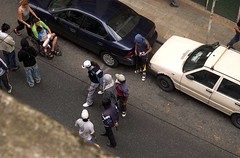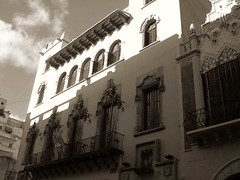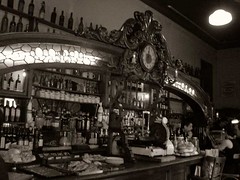February 2006
Monthly Archive
I also could have titled this post “Wake-up Drums”. I’ve again been staying up very late writing (not blogging), often till 3 or 4 am, so I sleep late. Today I was awaken by the sounds of drums. It’s not the first time. I crawled out of bed to the window and saw a group of piqueteros with their drums and banners. Interesting sight actually to see below your bedroom window, particularly when you don’t live on a major avenue.
There’s a lot of road construction in this area. They seem to come in by train to the Constitucion station. Normally they would go up Av 9 de Julio or Bernardo de Irigoyen but the construction of new ramps on and off of the autopista is causing major traffic problems. So, I guess our street – calle Brasil – is a good detour.
The photo is of the piqueteros, with their sticks and masked faces, who block the traffic while the marchers go forward. Notice in the photo that they’re not entirely inconsiderate (as often portrayed) as they make way for a woman from the neighborhood who is pushing her handicapped son in a wheelchair.
Actually, that’s another story – being confined to a wheelchair in Buenos Aires must be incredibly difficult with the crumbling sidewalks and the lack of handicapped entrances to most buildings.
In a recent post about the Mothers of the Plaza de Mayo, I mentioned the Grandmothers of the Plaza de Mayo who are focused on identifying the children who are born in captivity or kidnapped with their parents during the last military dictatorship in Argentina. Recently, the Grandmothers announced that they had identified another missing child, which now brings the total to 82 children that they have recovered in their 27 years of searching.
An article in Clarín, in Spanish, says that the identified child is now a man of 28 who goes by the name of Sebastián. His parents, Gaspar Casado and Adriana Tasca, disappeared in 1977 and he was born in captivity the following year. His parents are still missing.
After his birth, the boy was given by an Army officer to another family. The family registered the boy as their own with the aid of doctor associated with the Buenos Aires police.
As he grew older the boy had doubts about his identity and last year contacted the Grandmothers association by email. They established his identity and introduced him to his maternal grandmother. He recently received results of DNA analysis that proves the relationship.
As I’ve also mentioned several times on this blog, an excellent book about this subject is Searching for Life: The Grandmothers of the Plaza De Mayo and the Disappeared Children of Argentina
Saturday night we went to the park in Palermo to see Mercedes Sosa perform. It was a free concert on a nice summer night, so there was a huge crowd. It wasn’t the Stones in Rio but it was still a lot of people. I’ve written before about Mercedes Sosa where I talked about seeing her in Miami Beach a few years back. At that show I had a seat on about the 10th row; last night, it seemed like we were on about the 500th row. But we really enjoyed it anyway.
She had a number of guests who came onstage to sing with her, including Diego Torres. But the big surprise of the night was Charly García who joined Mercedes Sosa towards the end of the concert for three songs.
The New York Public Library Digital Gallery has a small collection of 28 digitized images of posters advertising Yiddish theater performances in Buenos Aires during the 1930s and ’40s. NYPL places the items in a comparative perspective with a larger set of posters advertising Yiddish theater in New York during the early 20th century. The NYPL online guide says,
In Buenos Aires, by contrast, the story was quite the reverse. Yiddish theaters had existed there since the beginning of the 20th century, but, controlled by mobsters and patronized by the city’s rollicking Jewish underworld, they had taken on something of the character of the burlesque house and, accordingly, were given a wide berth by members of the official, respectable, larger Jewish community. It was not until the end of the 1920s that the genteel element, with its aspirations toward community and cultural advancement, prevailed. With encouragement from such figures on the New York scene as Thomashefsky, who would visit for the winter while their own companies were closed for the summer, a modest golden age ensued, through the 1930s and into the 1940s, that made Buenos Aires the second city of the world history of Yiddish theater.
The mobsters and “rollicking Jewish underworld” must be a reference to the Zwi Migdal, a bizarre and notorious Jewish criminal organization. I’ll be writing about the strangely fascinating history of Zwi Migdal in a future post.
Santiago in Brooklyn, who appears to be a transplanted porteño, has a funny posting titled Are you from Buenos Aires? with a list of You know you’re a porteño when:
– Nothing is good anymore, it’s bárbaro
– You can walk the entire length of Florida without being heckled once by a money-changer or flyer distributor
– You think nothing of hopping on a bus for 15 hours to get away for the weekend
– You don’t find it surprising that 2 of these hours are spent leaving the city
See his site for more….
We forgot to make reservations for Valentine’s dinner at a nice restaurant. The ones we called at the last minute were all booked, so we just decided to wander around San Telmo looking for a nice place. We ended up at the restaurant of the Casal de Catalunya and it turned out to be a very nice evening.
We’ve noticed this building several times, located at Chacabuco 855. It’s the cultural center for the Catalan community in Buenos Aires. The interior of the building is very nice and architectural buffs should definitely visit it. From the glass front doors the restaurant isn’t visible and you have to ring the buzzer to let the staff know that you are there. Momentarily, a waiter will come to the door and walk you back to the restaurant. Just before the restaurant is a nice bar and a large, spiral staircase. Take a moment to look up at the winding stairs and you will see a beautiful stained glass window in the ceiling.
The tables in the restaurant are spread apart, giving everyone enough room for privacy and a long, relaxing meal. The waitress told us that the restaurant has just re-opened after being closed for many years. In celebration of their re-opening, they have a set menu with a per person price of $38 pesos that lasts until March 3. The regular menu is also available as an option. San Felipe wines are featured heavily in the menu.
For the $38 pesos per person, which includes table service, you get an opening glass of San Felipe extra brut, choice of appetizers, entree, dessert, a bottle of San Felipe wine, and a closing shot of San Felipe Roble Tardio.
For appetizers we got the hongos and the jamón serrano. For the entree, Ceci got the salmon with grilled vegetables and I got the arroz negro with chipirones. I would have preferred more calamari with mine but it was still very good. Midway through, we exchanged plates and also can say that the salmon and vegetables were very good, too. Finally, we both had crema catalana quemada for dessert.
I’m not a great culinary expert and don’t get too excited about any restaurant. The neighborhood parrilla is normally fine with me, but I enjoyed dining at Casal de Catalunya. I recommend it for when you’re in San Telmo and want to avoid the more touristy restaurants.
And, again, the building itself is quite a gem. The building also features the Teatro Margarita Xirgu. We didn’t actually get to see the inside of the theater but I suspect it’s a nice place to see a performance.
Last week a friend of a friend was in town. He was staying in San Telmo, so we took him over to Bar El Federal for dinner. Located on the corner of Perú and Carlos Calvo, El Federal is one of those classic bars and cafés of Buenos Aires. Indeed, El Federal is one of the most picturesque places in the city. Yet, that also means that it is full of tourists. All around us everybody was speaking English. If it wasn’t for all the tourists, I probably would go to El Federal often. The prices are still very reasonable, no more than any other café in town. It’s surprising that they haven’t raised the prices with all the tourists that are in there. The food was decent but the service was incredibly slow. It took thirty minutes for the waiter to take our order; however, it was only that waiter’s second day and they were busy. We had a leisurely evening planned anyway, so it was okay.
El Federal does have a beautiful bar. Photos just don’t do it justice. So, I would say that tourists definitely should consider El Federal as a place for stopping. (Plenty of other good, old bars in San Telmo which I need to cover in another post). Locals who have never been to El Federal should visit it at least once. Also, there’s a quaint little bookstore deep inside the café. Most of the books are used and overpriced (compared to the bookstores on Corrientes) but it’s interesting to browse for a few minutes.
I ran across an interesting series of postings Michael Alvarez, a professor of political science at Cal Tech, who observed last October’s election in Argentina, particularly a pilot project for e-voting. It’s an interesting series of readings:
Buenos Aires e-voting pilot project
Election observation in Buenos Aires — understanding the process
Initial impressions of Buenos Aires e-voting pilot project: physical security (I didn’t realize until reading this about the involvement of the military in Argentine elections).
Testing, testing, testing; the Buenos Aires pilot project
Qualitative evaluation of Buenos Aires e-voting pilot project available, includes a link to an 11 page report in PDF.
Voting Machine Prototypes Put to Test in Argentina, from electionline.org.
I went with Ceci last October when she voted. From what I saw, the voting process went very smoothly. Then again, in comparison, I remember voting with the now infamous punch card ballot in south Florida during the 2000 election disaster and in 2004 with the e-voting devices where it seemed like most of the poll workers had no idea how the devices worked. South Florida is a place that really needs election observers!
 Last month Ceci and I walked over to the Constitución station and took a bus to Quilmes. After about 45 minutes on the late afternoon bus, so crowded with commuters that we had to stand for half the trip, we arrived at our destination. There we met Ceci’s cousin Ani and the two of them proceeded to give me a tour of Quilmes and introduced me to the story of their maternal grandparents – “El Nonno & La Nonna”.
Last month Ceci and I walked over to the Constitución station and took a bus to Quilmes. After about 45 minutes on the late afternoon bus, so crowded with commuters that we had to stand for half the trip, we arrived at our destination. There we met Ceci’s cousin Ani and the two of them proceeded to give me a tour of Quilmes and introduced me to the story of their maternal grandparents – “El Nonno & La Nonna”.
Buenos Aires is filled with families descended from Italian immigrants. Many came in the late 1800s, others throughout the early and mid 20th century. The life of Oliverio D’alessandro is perhaps similar to many other Italians who immigrated to Argentina after World War II.
Oliverio D’alessandro was born on the thirteenth of January in 1913. His hometown was San Vito Chietino (pictured), which is located on the Adriatic coast of the Abruzzo region of Italy. There he married Ana Di Paolo and they started to live the lives that had been lived for generations in that small town on a hill overlooking the sea.
The German occupation of San Vito Chietino ended the tranquility and, as with so many families, would change the lives of Oliverio and Ana forever. In 1940 Oliverio was given an option by the Germans to go to work without pay in the coal mines of Germany or to fight on the front. He chose the coal mines.
The same year that he left Italy for the mines in Germany, his first child was born. She was named Italia and is Ani’s mother.
His wife, Ana Di Paolo, stayed with her family in San Vito Chietino and cared for her young baby girl. The German would loot the houses regularly, taking whatever they pleased and treated all the women of the town terribly. Ana placed the family’s valuables, including fabrics and linens, into a trunk which she hid behind a staircase. She built a wall around on the back of the stairs to conceal the trunk from the Germans.
Oliverio worked in the German mines for three years, finally returning to San Vito Chietino in 1943. Later that year, his second child, Gilda, was born; she is Ceci’s mother.
Just weeks after Gilda was born, planes of the Allied forces bombed San Vito Chietino. During the next year Germans counterattacked and the town was evacuated. During one of the attacks Ana’s brother was killed by a bomb. His wife went to his aid, trying to rescue him but she was also killed.
After the War, work was scarce in Italy. Oliverio – along with many other Italians – went to work in the coal mines of Belgium in 1945.
In 1949, after four years or working in the mines, Oliverio and four Italian friends also working in the Belgian mines decided to go to “America.” At first, they tried to obtain passage to Venezuela but visas were no longer being granted. They were told to try the Argentine consultate, where they were able to obtain the necessary documents for traveling to Argentina. The five men sailed to Argentina in 1949.
On the advice of his godfather, who had preceded him to Argentina, Oliverio settled in Quilmes. He found work in a textile factory, brought some land, and built a home in Quilmes for his family.
In 1952, three years after he arrived in Argentina, Oliverio was able to pay for his family to journey across the ocean to join him. Ana and her three daughters (another child – Maria – was born after the War) embarked on the long voyage by themselves from Italy to Argentina. Ana also brought with her the trunk of fabrics and linens that she had hid from the Germans during the War. The family settled into the house in Quilmes that Oliverio had built for them.
Ani and Ceci drove me by that house in Quilmes. Just off the plaza at the center of the town is the old school where the young daughters of Oliverio attended school after they moved to Quilmes. While the three daughters adjusted to life in their new country, their mother never learned to speak Spanish even though she would live in Argentina for more than thirty years.
After Oliverio retired from the factory in 1976, he and his wife traveled back to Italy for a visit.
La Nonna passed away in 1986. El Nonno lived a long life, became a gardener and rode his bike everyday. He passed away at the age of eighty-five in 1998.
Quilmes itself is a pleasant town. We walked around the center of town and then Ani drove us around several of the neighborhoods. Then it was a drive out to the long river front. Quilmes is centered around the huge brewery named after the city. Near the brewery is a quaint barrio of charming small houses originally built for workers of the brewery. Nearby is also a very nice park, with a restaurant that features all things Quilmes (mostly the beer, not just the town). There we raised a toast to their grandparents and the life they built for their family in Argentina.
Later, in a humorous way, we found out that Ita and Gilda, Ani & Ceci mothers respectively, were themselves on their own tour of Quilmes that very evening…perhaps hoping to accidentally bump into us…ah, Italian mothers.
Other posts related to the topic of Italian immigration to Argentina



